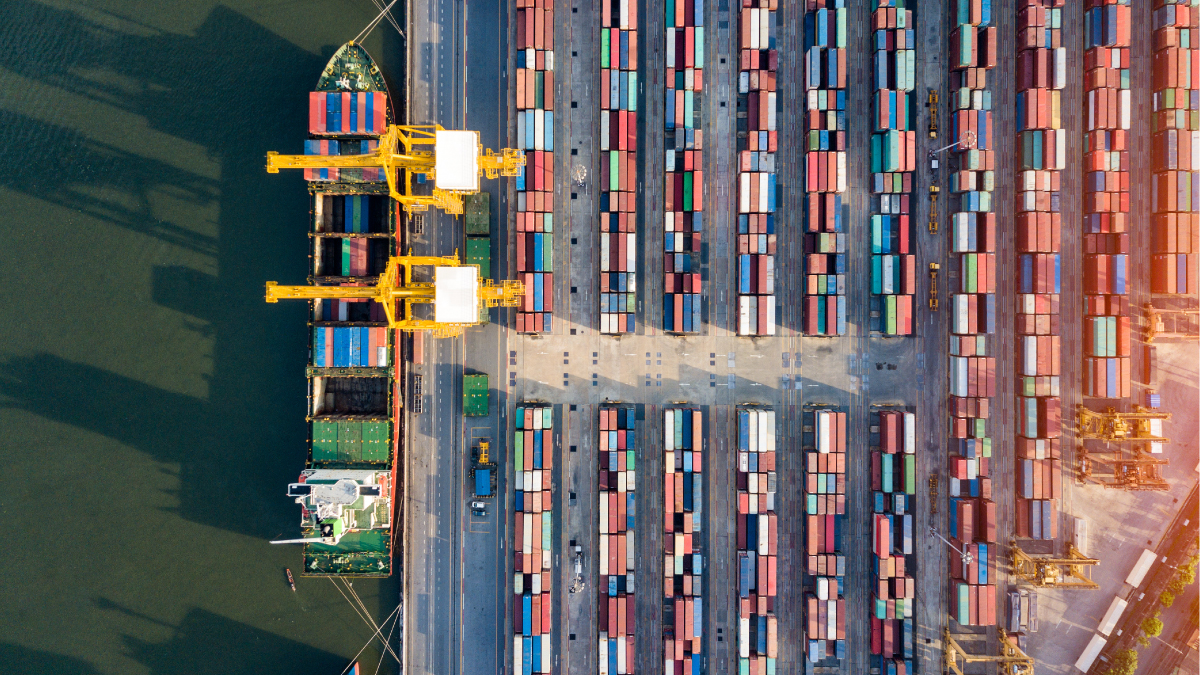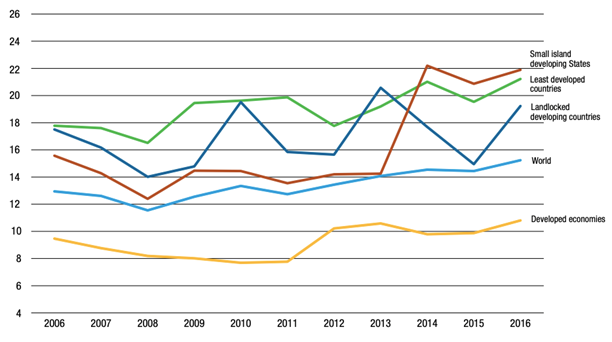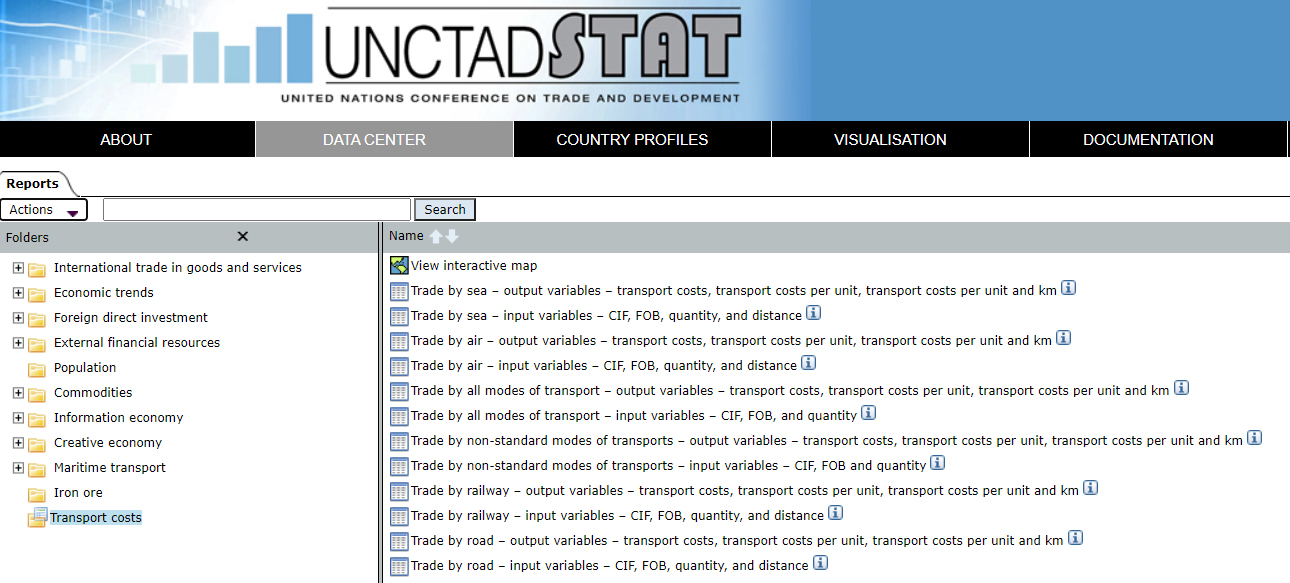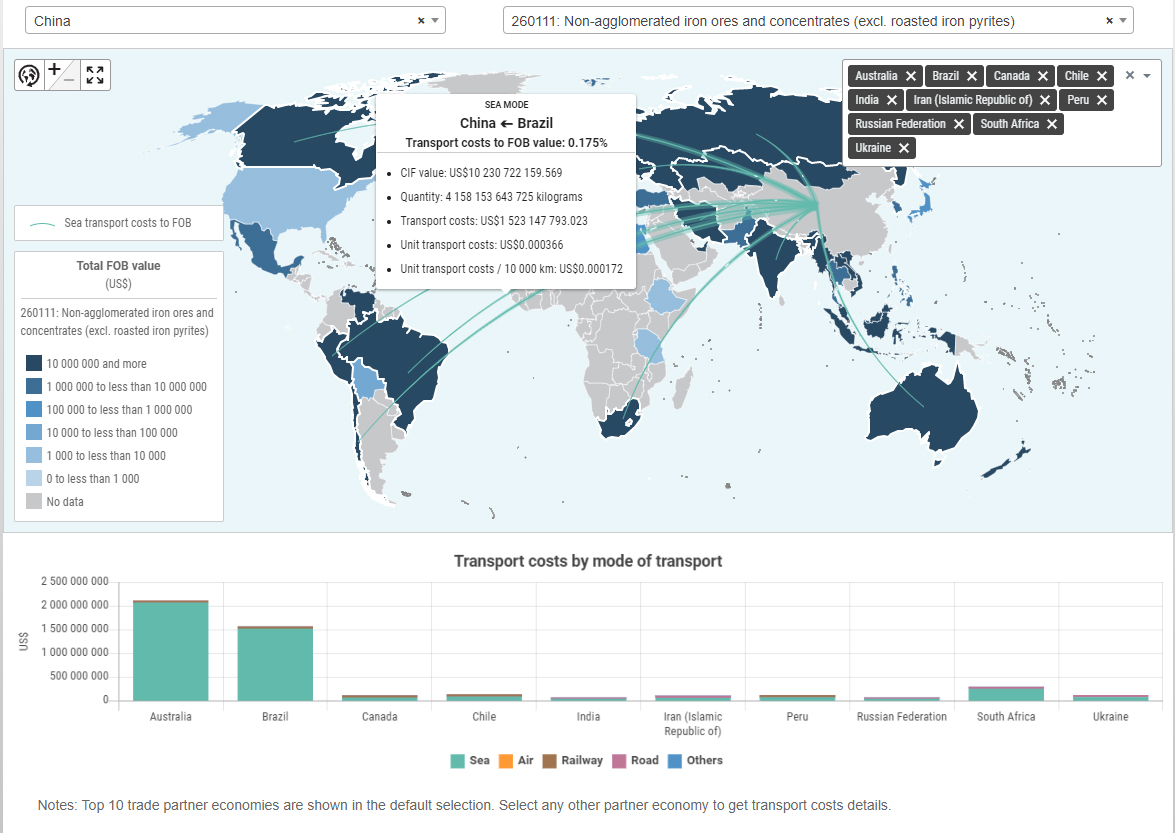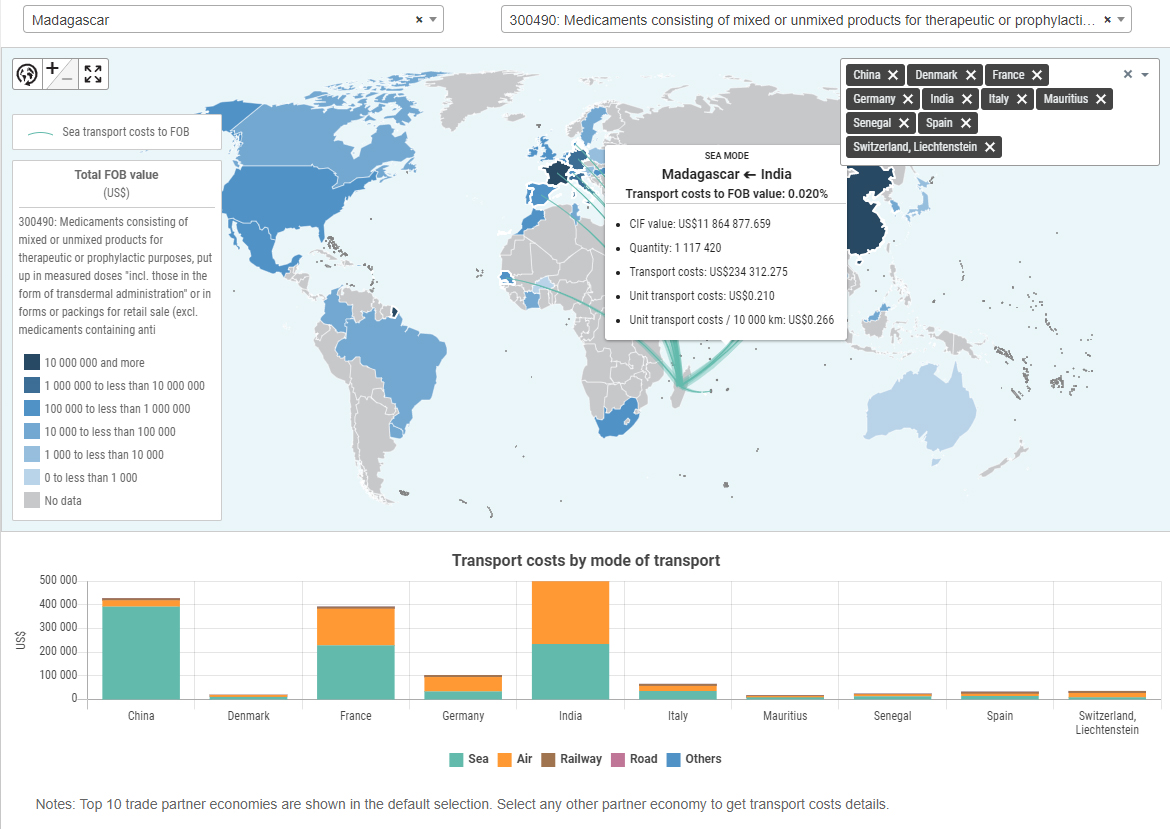Written by Nour Barnat, Jennifer Brown, David Cristallo, Goran Dominioni, Dominik Englert, Ronald Apriliyanto Halim, Jan Hoffmann, Onno Hoffmeister, Nicholas-Joseph Lazarou, and Wendela Schim Van Der Loeff, Article No. 69 [UNCTAD Transport and Trade Facilitation Newsletter N°89 - First Quarter 2021]
Insights from the new global transport costs dataset developed by UNCTAD and the World Bank
To support transport policymaking that is evidence-based and sustainable, the United Nations Conference on Trade and Development (UNCTAD) and the World Bank have developed a Global Transport Costs Dataset for International Trade. This new dataset, launched on 10 December 2020 in collaboration with the International Maritime Organization’s (IMO) Technical Cooperation Committee, aims to facilitate informed and sound decision-making processes in sustainable transport. The new estimates of international transport costs are expected to contribute to closing the persistent data gap faced by policymakers, researchers and other transport industry stakeholders.
Explaining differences in global transport costs
International transport is central to global trade and countries’ economic prospects. Yet, the costs of transporting commodities vary widely across countries, routes, directions and commodities. Often, small island developing States (SIDS), landlocked developing countries (LLDCs), and least developed countries (LDCs) spend more than average on the international transport and insurance of their merchandize imports.
Figure 1: Transport and insurance costs of international trade, 2006–2016
(Percentage share of value of imports)
Source: UNCTAD, Review of Maritime Transport 2017
A wide range of factors cause these variations in transport cost levels: for instance, distance and geographical location, size of economies and markets, scale effects, market structures, connectivity to transport networks and infrastructure availability and quality can play an important role.
The data presented in Figure 1 were derived from country-level estimates combining all modes of transport, all commodities, and all country pairs. The new UNCTAD-World Bank dataset on international transport costs will allow users, including policymakers, researchers, transport practitioners, and industry stakeholders to compute similar data but at a more granular level. It will now also feature details relating to the specific mode of transport, the commodity, and the country pair.
Addressing practical needs for estimating transport costs
The timing of this new international transport costs dataset has been motivated by an urgent practical need for more granular, global and up-to-date information. Member States of the IMO are currently negotiating appropriate GHG reduction measures for ships, and these measures under consideration need to undergo impact assessments before being adopted. In this context, the IMO document Marine Environment Protection Committee (MEPC) 75/WP.3 of November 2020 states, for example, that “[A]chieving global reductions in GHG from international shipping is the highest order priority and we must avoid a situation where the adoption of measures becomes stalled due to lack of data, information, or baselines with which to properly assess the potential impacts”. Echoing this statement, the document further highlights “the identification of areas of missing data” in the terms of reference and arrangements for the conduct of a comprehensive impact assessment of a specific short-term measure before MEPC 76 scheduled for June 2021.
Responsible for transporting around 70 percent of global trade by value and more than 80 percent by volume, international maritime transport plays a key role in providing low-cost transport opportunities. Without this crucial service, countries' ability to meet their citizens' needs through the basic supply of essential goods such as food, clothing, shelter, and pharmaceuticals would be undermined.
At the same time, international maritime transport represents an important source of global carbon emissions. The IMO Fourth GHG Study outlines that the sector currently accounts for around 2.89 percent of global GHG emissions. These GHG emissions are set to grow further in the coming decades under a business-as-usual scenario. To counter this growth, and to put shipping on a GHG trajectory aligned with the Paris Agreement’s temperature goals, the IMO adopted its Initial GHG Strategy. As a result, the sector has committed to cut GHG emissions from ships by at least 50 percent by 2050 compared to 2008 levels.
Aiming for more global and more granular information
In the past, several efforts have already been successfully undertaken to measure international transport costs based on reported trade statistics. These include, for instance, the International Transport Costs data base maintained by ECLAC and the International Transport and Insurance Costs of Merchandise Trade data base maintained by the OECD. However, these are usually limited in their geographic scope and level of detail. Still today, many countries fail to report their international trade accurately due to language barriers, weak statistical systems, or lack of technical capacity with these capacity constraints being especially evident in SIDS and LDCs.
To enhance this existing evidence base, UNCTAD and the World Bank have joined forces to provide a new additional analytical piece to the global transport data puzzle. By publishing this dataset, the two partners aim to complement existing datasets and knowledge networks, thereby improving technical capabilities globally.
The project team benefited from new and expanded raw data made available in the United Nations International Trade Statistics Database known as COMTRADE. Notably, in its newest version COMTRADE Plus, this raw data now includes fields for the mode of transport, as well as both the declared values FOB (Free on Board) and CIF (Cost Insurance Freight).
In the context of the IMO Initial GHG Strategy, the new Global Transport Costs Dataset for International Trade seeks to enable policymakers and researchers to assess the expected impacts of specific GHG reduction measures for ships on the transport costs of the most relevant export or import commodities in specific countries. By displaying the transport costs in a multi-dimensional format, users can compare the transport costs across country pairs, commodities, and, most importantly, transport modes, thereby providing valuable input for the development of detailed impact assessments.
The dataset provides the total transport costs, transport costs per unit, transport costs per unit per kilometre as well as the transport costs to FOB ratio (Figure 2).
Figure 2: Extract from the Global Transport Costs Dataset for International Trade
Source: UNCTADstat, https://unctadstat.unctad.org/datacentre/
Leveraging model estimates and mirror data to fill data gaps
The opportunity to develop this new dataset has arisen due to a recent change in official reporting guidelines for international trade. These guidelines for countries now recommend bilateral trade to be reported by distinguishing between different modes of transport (that is sea, air, railway, road, and others). This new, more granular information has allowed for the development of a specific mode-of-transport model that can break down bilateral trade in a commodity group, recorded in the COMTRADE Plus database, by five modes of transport, thereby allowing to edit implausible values and fill gaps in the reported data.
Second, a complementary transport-costs-model, also developed in the context of this project, exploits the simultaneous recording of CIF and FOB values in COMTRADE Plus to make predictions for FOB values when these are not reported by countries. Third, a specific quantity-value model has been developed and used to impute missing quantity values. The accuracy of those predictions is further augmented by the comparison with mirror data (and soon also by trend data for subsequent years).
That way, the dataset provides the most extensive coverage of any public transport costs dataset so far. It features information on transport costs, broken down by mode of transport, from 105 importing countries and over 200 exporting countries, that way depicting around 95 percent of the global merchandise trade in terms of value. Moreover, the dataset is set up to enable continuous improvements and updates in data quality and completeness. Ultimately, the dataset has also been linked with an interactive map that enables users to visualise the flow of commodities and their related transport costs between country pairs (Figure 3).
Figure 3: Extracts from the Global Transport Costs Dataset for International Trade
Source: UNCTADstat
Creating a system that allows for expansion and improvements over time
To date, the first dataset developed by UNCTAD and the World Bank, and published under UNCTADstat still remains limited in its coverage of just one year (2016). More importantly, however, is the system that has been put in place to allow UNCTAD to expand, update, and further enhance the published data over the coming years. It is already evident that in the years following 2016, more countries are providing more detailed information with wider coverage to the COMTRADE Plus database. The system is therefore ready to incorporate these new data, leading to an even broader and more robust evidence base in the future.
The overall dataset has been jointly developed by UNCTAD and the World Bank. Equitable Maritime Consulting has provided technical advice, especially with regard to the estimation of modal shares of major transport modes. Given the special interest in maritime transport, the work has been kindly supported by PROBLUE, a multi-donor trust fund housed by the World Bank in support of the development of integrated, sustainable and healthy marine and coastal resources.
Over the coming months, it is planned to further enhance and refine the dataset, especially with regard to adding more years of reported and estimated data. The dataset will thereafter be updated and reviewed on an ongoing basis. Over the course of this process, the developers welcome any feedback on the usefulness and usability of the dataset as well as any other suggestions to enhance its added value for stakeholders in global transport and trade.
To access the data sets, see “Transport Costs” here: https://unctadstat.unctad.org/datacentre/?IF_ActivePath=P%2C11
To access the interactive map, see here
https://unctadstat.unctad.org/EN/TransportCost.html.
Contact the authors:
Nour Barnat | Statistician, Chief of Method Unit| UNCTAD |
[email protected]
Jennifer Brown | Consultant| World Bank |
[email protected]
David Cristallo | Chief, IT Unit | UNCTAD
[email protected]
Goran Dominioni | Consultant | World Bank |
[email protected]
Dominik Englert | Economist, Climate Change Advisory and Operations | World Bank |
[email protected]
Ronald Apriliyanto Halim | Partner | Equitable Maritime Consulting |
[email protected]
Jan Hoffmann | Chief, Trade Logistics Branch | UNCTAD |
[email protected]
Onno Hoffmeister | Chief, Statistics Production Unit | UNCTAD |
[email protected]
Nicholas-Joseph Lazarou | Consultant | World Bank |
[email protected]
Wendela Schim Van Der Loeff | Consultant | World Bank |
[email protected]

